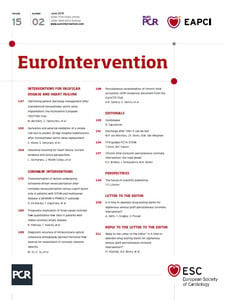We read with interest the article by Elgendy and colleagues entitled “Drug-eluting stents versus bare metal stents for saphenous vein graft revascularisation: a meta-analysis of randomised trials”1. The authors did not find any difference between drug-eluting stents (DES) and bare metal stents (BMS) and recommended novel therapies for saphenous vein graft (SVG) percutaneous coronary intervention (PCI). We would like to point out several issues which may result in erroneous interpretation and conclusion about an important problem in interventional cardiology. First, a sensitivity analysis performed by the authors to detect the influence of an individual study on the major adverse events was reportedly negative. However, on closer inspection, excluding the smallest trial from a single centre, DELAYED RRISC, shows that DES significantly reduce the risk of major adverse events at the longest follow-up (risk ratio [RR] 0.64, 95% CI: 0.42-0.98) contrary to the reported conclusion, hence challenging its robustness. Many differences between this particular trial and other studies may explain this finding. Second, the authors performed a subgroup analysis to assess the difference between treatment effect within 12 months and that after 12 months (late follow-up) of the procedure (Figure3 of the manuscript) and reported no difference. The reported analysis is flawed because, rather than censoring the patients who had an event within the first 12 months as well as individuals at risk in the late follow-up subgroup, all patients and events were included in the late follow-up subgroup except those in the ISAR-CABG study. On appropriately censoring the patients with events2, there was a strong trend to suggest a between-group difference for the treatment effect of DES vs. BMS within 12 months versus after 12 months from the procedure (RR 0.57, 95% CI: 0.36-0.89 for <12 months, RR 1.19, 95% CI: 0.64-2.20 for >12 months; pinteraction=0.06) despite the limited power of such analysis. Furthermore, meta-regression of the timeframe (within 12 months or >12 months) on treatment effect also confirmed significant interaction (p=0.04). These findings are further supported by recent five-year follow-up of the ISAR-CABG study, not included in the analysis3.
In summary, this meta-analysis clearly demonstrates superiority of DES over BMS in SVG PCI at one year, although the effect size appears to diminish after >12 months of follow-up. The so-called late catch-up phenomenon has been well described, particularly after first-generation DES4. All but one of the trials included in the meta-analysis used first-generation DES. Furthermore, with continuous improvement in stent technology, the repeat revascularisation rates after contemporary BMS have reduced significantly, requiring a large sample size and prolonged follow-up to demonstrate superiority of DES in native coronary artery disease5. Therefore, in the absence of an adequately powered randomised trial or a robust meta-analysis demonstrating futility, and a possibility of improved outcomes at 12 months instead, why should we abandon DES for SVG PCI just yet?
Conflict of interest statement
The authors have no conflicts of interest to declare.

